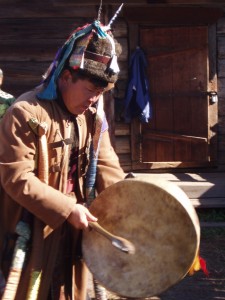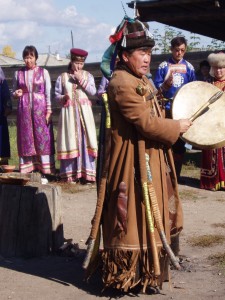On a trip to Lake Baikal, I hired a guide to take me to a local shaman, intrigued to see what similarities there may be with early religion in Japan. Here’s a short account of the meeting.
****************

Siberian shaman drumming up the spirits
Prompted by my guide, I proffered the bottle of vodka we had brought. The shaman wetted his fingers and flicked the liquid away in offering, then took an enormous gulp and called on the Sky God to intercede with my father and bring harmony between us. Other exchanges followed about my path in life, including a prediction that I would find success in later years. Then with a few guttural sounds and jerky movements, the shaman opened his eyes and looked with glazed eyes as if searching for something in the distance, then slowly his focus returned. ‘So there you are,’ he said, back in his normal voice. He smiled, but he was clearly drained of energy.
From the vodka bottle he poured us each a shot, and with the guide to translate I asked a few questions. How had he become a shaman? ‘My father was a shaman, but under Communism it was not allowed to practise. So we did in secret, just inside the house. I learnt from him. Entering a trance requires training and practice. It’s not something undertaken lightly. You feel something mysterious getting closer, rising within you, like a dark force taking over your consciousness, so.you have to make way. After some time, it’s impossible to say how long, that other being, that spiirit departs and your consciousness returns and takes over. It’s exhausting. It’s difficult to explain unless you’ve experienced yourself.’

Siberian shamanism: did it pass into Japan through Korea?
Give the ban on shamanism, I wondered if he had ever had another job? ‘Yes, I used to work for the police,’ he laughed. ‘I was in administration. Everyday working in an office. My salary was good, my position was good. It was interesting work. But when I was 30, I became troubled, I got a high fever and had to stay in bed. Something was wrong with me, my body hurt, so I went to a doctor but he could find nothing. I tried other doctors, but they could not see anything wrong. But my condition was so bad I had to give up work, then in desperation I went to a shaman who said the spirits were calling me. It was a shock, because I had never thought about those matters since childhood. I didn’t feel a connection to the spirit world at all. But when I consulted him, my pains stopped and I felt better. For me it was proof that I was on the right path. The spirits knew better than the doctors.’
So-called ‘Siberian illness’ is common among those destined to be a shaman, as if the suffering is a necessary prelude to the acquisition of wisdom. Being chosen in this way leads to an apprenticeship, which includes techniques like fasting, purification, visualisation and learning how to invite spirits into ritual implements such as the drum. The ascetic rites are so severe that many drop out. Who knows, but perhaps ancestral memory of this underwrote En no Gyoja’s austerities which led to the foundation of Shugendo. Still to this day shamanic rites are held by those who have undergone fasting and ascetic exercises in the heart of the mountains.

Lake Baikal is an amazing place ecologically as well as culturally, as you would know John. I’d love to visit there one day. The long term connections between Japan, Korea and other Asian countries suggests there would have been shamanic links between the different cultures. You would imagine the Jomon people to be shamanistic as well, like other animistic cultures. So like many things in Japan shamanism is likely to be a blend of indigenous and introduced characteristics. No doubt much as been written since Elaide wrote about the obscure origin of Japanese shamanism in 1951. At the time he noted that most Japanese shamans have been women. I’m unsure how that sits with Shugendo where many of the shamans were/are men. It’s a fascinating subject I have much more to learn about.
Many thanks for those thoughts, Jann. The female shamans of ancient Japan are typified by Himiko, who worked with a male ‘brother’. Obviously the human vessel of a kami needs to be as pure as possible, and an undefiled female would best fit that bill. Hence vestal virgins and miko. Children too are held to be pure and innocent,which is why you find ‘chigo’ at the Gion Festival and elsewhere. The change to male priests came around the seventh and eighth century I believe, when state control of shrines was imposed and priests had to act more as functionaries than mediums. How this affected Shugendo I’m not sure, given that its founder En no Gyoja was male. It would be interesting to learn about the fate of female shamans in Shugendo, so if you come across anything on the subject please let us know.
By the way, Jann, I’d like to look up the Eliade comment. I don’t suppose you have a reference? Thanks if you can provide one….
Thanks for the amazing article, but I didn’t understand, he said he became a Shaman or learnt Shamanism by his father when he was young then he said he worked for 30 years in the police then he became a Shaman and before that he didn’t have a connection to the spiritual world!
Thank you for taking the trouble to write in and point that out. The situation was that his father taught him as a child, but he grew away from that and entered the police force. At age 30 he became ill, couldn’t find the reason, consulted a shaman in desperation and became convinced that the spirits were calling him. I’ve tweaked the writing somewhat to try and make things clearer. I wonder if it works now?
Yes it’s all clear now, thanks!